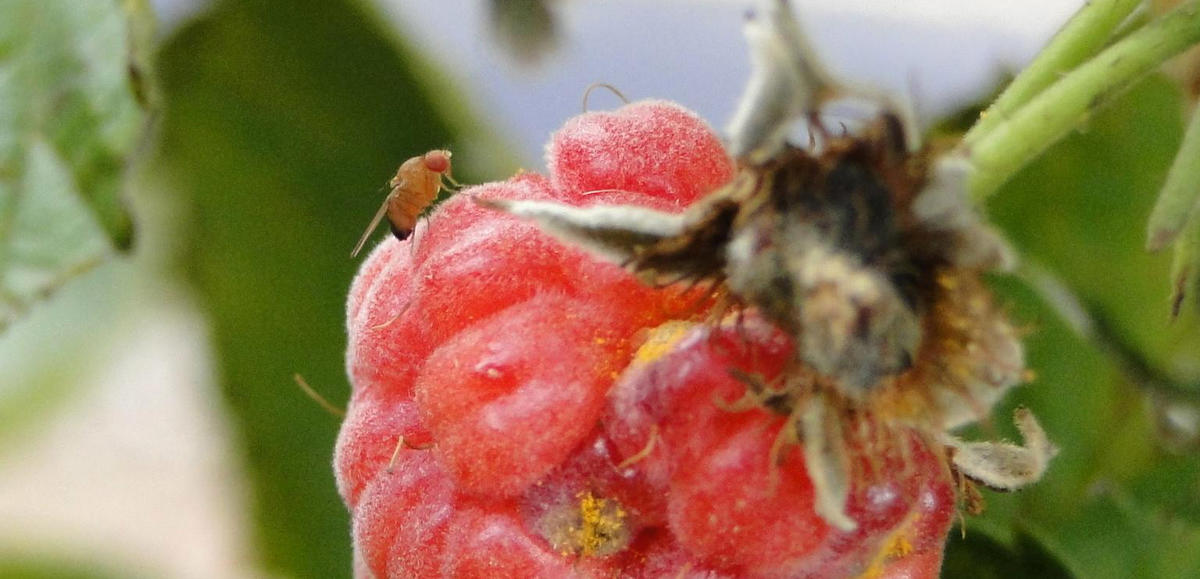
Spotted wing drosophila fly on a raspberry
Image credit: “THE FLY -- Adult spotted Wing Drosophila on a raspberry” by Hannah Burrack, North Carolina State University, Bugwood.org. Photo has been cropped. Licensed under CC BY-ND 2.0.
Background
Spotted wing drosophila (SWD, Drosophila suzukii) is an invasive fruit fly that has been present in Minnesota since 2012. Female flies infest soft, ripening fruits. Small fruit acreage in Minnesota exceeds 1,500 acres, and crop losses have been reported as high as 40, 20 and 50 percent in strawberry, blueberry and raspberry, respectively.
Management techniques for SWD have been limited to repeat applications of broad-spectrum insecticides. A lack of understanding of the basic biology and behaviors of SWD has prevented experts from offering more sustainable, pest-specific control recommendations.
This project had three goals to move Minnesota forward on SWD:
- Improve SWD forecasting by better understanding local movement patterns, long-distance migration and potential overwintering locations
- Evaluate the success of innovative, alternative management techniques
- Evaluate the cost-efficiency and economic impact of SWD management alternatives and develop decision-making tools for Minnesota berry growers
Whether through the use of innovative field research techniques like unmanned aerial vehicle (UAV) flight—where drones are used to capture SWD migration patterns in air currents—or old-fashioned conversation with berry growers on the ground, this team worked to change the outlook of SWD in Minnesota.
Research questions
- Can we forecast seasonal SWD populations via overwintering and local migration data?
- How effective are novel biopesticide products like erythritol, lufenuron and spider venom for SWD control on raspberries in the field?
- How effective are poly-covered high tunnels and fine mesh netting on reducing SWD damage in raspberries?
- What is the current economic impact of SWD on the Minnesota raspberry industry?
- What are the potential costs and benefits associated with alternative SWD management practices?
Outcomes
Researchers developed new cost-effective methods to help growers manage damage and reduce yield loss caused by SWD in small fruit while reducing pesticide use. Additionally, they gained and documented basic knowledge on the behavior and flight capabilities of this pest that will contribute to future management strategies. There is indirect evidence showing that SWD may be overwintering and little evidence that the SWD has the flight capabilities for long-distance movement. Physical exclusion can effectively reduce SWD damage, is cost-effective for small farms, and reduces the need for insecticide sprays. The science-based management recommendations for this best improves overall sustainability of small fruit production in Minnesota.
Publications
- Comparing Drosophila suzukii flight behavior using free-flight and tethered flight assays (Entomologia Experimentalis et Applicata, 2022)
- Partial Budget Analysis of Exclusion Netting and Organic-certified Insecticides for Management of Spotted-wing Drosophila (Diptera: Drosophilidae) on Small Farms in the Upper Midwest (Journal of Economic Entomology, 2021)
- Deterrent Effects of Essential Oils on Spotted-Wing Drosophila (Drosophila suzukii): Implications for Organic Management in Berry Crops (Insects, 2020)
- Two-Stage Batch Algorithm for Nonlinear Static Parameter Estimation (Journal of Guidance, Control, and Dynamics, 2020)
- Morphometric criteria to differentiate Drosophila suzukii (Diptera: Drosophilidae) seasonal morphs (PLOS ONE, 2020)
- Economic Impact of Spotted Wing Drosophila (Diptera: Drosophilidae) Yield Loss on Minnesota Raspberry Farms: A Grower Survey (Journal of Integrated Pest Management, 2019)
- Efficacy of organic and conventional insecticides for Drosophila suzukii when combined with erythritol, a non-nutritive feeding stimulant (Crop Protection, 2019)
News and media
- Spotted Wing Drosophila information for growers (FruitEdge)
- Calculating Returns to SWD Control Measures (FruitEdge)
- UMN Extension Fruit and Vegetable blog: spotted wing drosophila search results
- Defending berries against spotted wing drosophila (Minnesota Fruit Research, 2018)
- Research reveals high cost of invasive species for Minnesota-grown raspberries (Minnesota Invasive Terrestrial Plants and Pests Center)
- 5 Ways Researchers Are Using Drones to Stop Invasive Species (Minnesota Invasive Terrestrial Plants and Pests Center)
- The Small Fruit Fly That Causes Big Problems (Minnesota Invasive Terrestrial Plants and Pests Center)